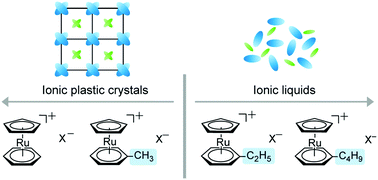We recently developed ionic liquids containing cationic sandwich complexes. However, salts of the sandwich complexes often exhibit ionic plastic phases with high melting points. To explore the boundaries between ionic liquids and plastic crystals of sandwich salts, we investigated, in detail, the phase behavior of ruthenium complexes [Ru(C5H5)(C6H5R)][X] ([C0][X]: R = H, [C1][X]: R = Me, [C2][X]: R = Et, [C4][X]: R = Bu). Among salts containing the anions PF6−, FSA−, and B(CN)4−, [C0][X] and [C1][X] are solids that exhibit plastic phases at or above room temperature, whereas [C2][X] and [C4][X] are mostly ionic liquids. Salts containing the C(CN)3− anion exhibited lower melting points than the other salts. X-ray crystallography reveals that the cations and anions in most of these salts are arranged alternately in the solid state. However, in the case of [C0][C(CN)3], the cations and anions are stacked independently, thereby providing weaker cation–anion interactions that account for the relatively low melting point of this salt.

